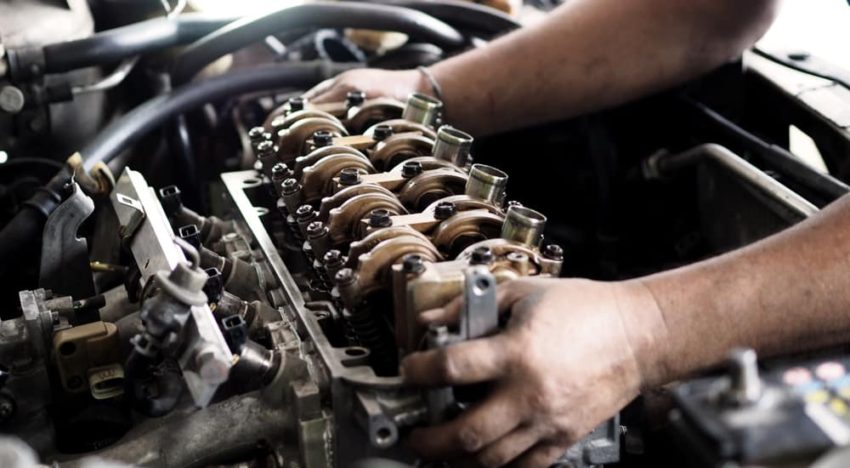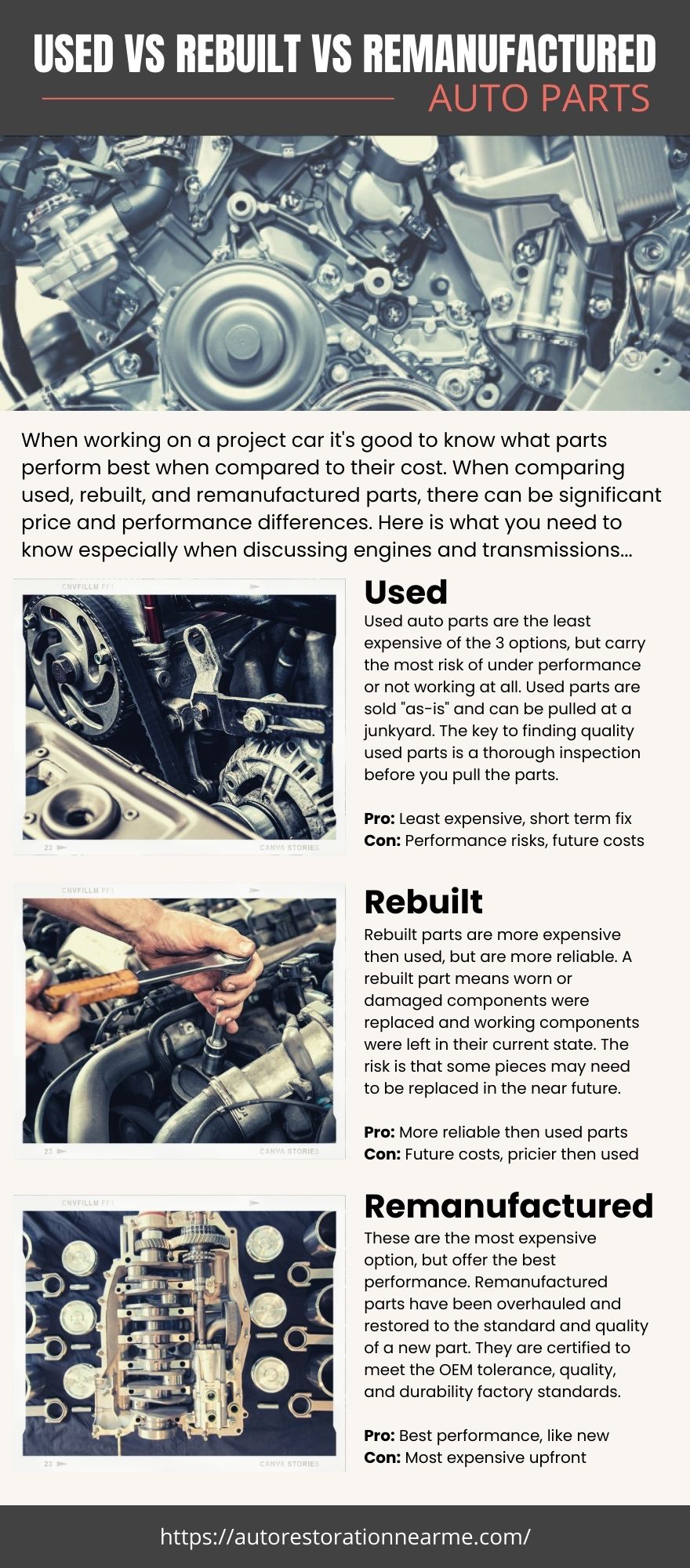When it comes to auto restoration, there is a balance between what types parts perform best and which type you can afford. When comparing used, rebuilt, and remanufactured auto parts there is a significant difference in price and performance. These conversations mostly revolve around two components that are commonly purchased used, rebuilt, or remanufactured: the engine and the transmission. In the article below I’ll discuss the pros and cons of each option as it pertains to engines and transmissions.
If you are doing a restoration project you must also consider how each type impacts the value of your vehicle. This will be a top consideration if you are concerned about keeping your vehicle original.
Used vs Rebuilt vs Remanufactured Auto Parts
Used Auto Parts
These are the least expensive, but may not perform as well as rebuilt or remanufactured parts.
When you buy used auto parts, these come in “as is” condition. These are parts typically bought at an auto salvage yard. Whether you are pulling a used engine or a used transmission the risk is the same. The parts could be seized up or have internal issues that you can’t see in a visual inspection. While you can certainly find good condition used transmissions and engines, you should have a mechanic inspect the parts before you install them.
From a price perspective these are the most cost effective parts you can get and help you get your auto restoration under budget. You can save over 65% vs buying new in many cases.
From a performance perspective used parts are more risky. You don’t know how it was used, how long it’s been sitting outside at a salvage, and if the vehicle was in an accident how it impacted the parts. For example a used transmission might have contaminated fluids, shifting problems, mssing internal parts and/or torque converter issues. You also don’t know the service history or if it has already reached it’s end of life.
To mitigate some of the risk of buying used you can check to see if the salvage yard offers you the ability to purchase a 30 day warranty. If you are doing a restoration, you can also consider finding specialized used parts vendors for classic cars.
Pros and Cons of Used Parts
Pro:
- Least expensive option when compared to rebuilt and remanufactured parts
- Can pull yourself at a salvage yard
- Good short term solution
Con:
- Carries the most risk
- May need internal components replaced or fixed
Rebuilt Auto Parts
Rebuilt auto parts offer better performance then used parts, but are more expensive and carry some performance risk.
When auto parts are considered “rebuilt”, all the worn out and damaged parts are replaced. Any parts in working condition are left as is. So you can see how this is an upgrade from buying parts that are used. For example a rebuilt transmission might have the clutch and torque converter replaced, but leave the bands, valve body, and original pumps in tact. For a rebuilt engine maybe all camshaft and cylinder head pieces are replaced and the top assembly, bottom assembly, and valvetrains are left alone.
The most important takeaway to understand about rebuilt engines and transmissions is that only some parts are replaced. That means parts that are not replaced may eventually need to be replaced at some point later. While you can buy rebuilt engines and rebuilt transmissions, it is certainly a process you can do yourself.
Pros and Cons of Rebuilt Parts
Pro:
- Better performance then used parts
- The parts have been inspected and setup to perform now
- Less expensive then remanufactured parts
Con:
- Other internal parts may need to be replaced later
- More expensive then used parts
Remanufactured Auto Parts
Remanufactured parts perform best and are also the most expensive.
Auto parts that are remanufactured have been completely overhauled and restored to manufacturers standards for new parts. There are some cases where remanufcatured parts outperorm the original parts from the factory. This happens when for example a part was manufactured in 1985, but in 1998 the manufacturer made design improvements to the part.
As an example, a remanufactured engine will have each component, not including the body, replaced or rebuilt to meet the OEM specification from the factory. Same for a remanufactured transmission, each part except the body is replaced or rebuilt to OEM tolerances. That means remanufactured parts will meet or exceed all quality and durability standards that the parts was original quality controled against in the factory.
Remanufactured parts are also signed off by a certified mechanic when the work is complete.
Pros and Cons of Remanufactured Auto Parts
Pro:
- Meets or exceeds OEM standards from factory
- The parts have been inspected, tested, and certified as remanufactured
Con:
- Most expensive when compared to used and rebuilt auto parts
What About New Auto Parts?
You may be wondering why not consider going for new parts. Well a new crate motor or a new transmission is going to cost significantly more. That and if you are doing a restoration, new may not even be an option for some vehicles. Really though the closest you can get to new in many cases for older vehicles is remanufactured.
Whats Best: Used, Rebuilt, or Remanufactured Parts?
Much of this depends on your situation and budget. You will likely have more long term success and performance when you choose rebuilt and remanufactured engines and transmissions as opposed to used.
For a rebuild, one thing to consider is that is a job you can do yourself at home. You have to take everything apart, inspect, replace everything thats worn or damaged, and then reassemble. You have the knowledge of everything that went into the part and can test it yourself.
Alternatively, a certified remanufactured auto part, while more expensive, has been completely rehauled to meet or exeed the factory specs.


